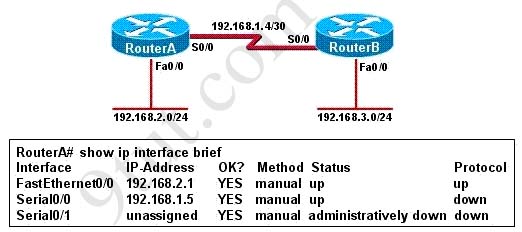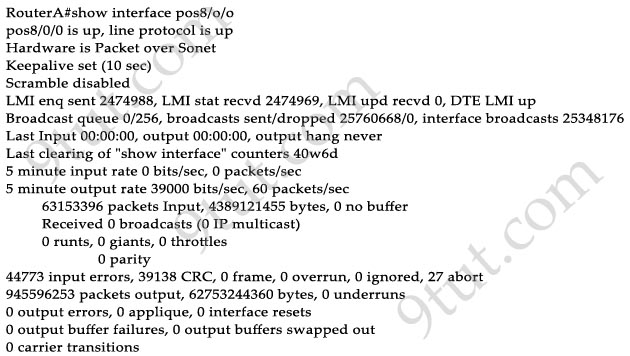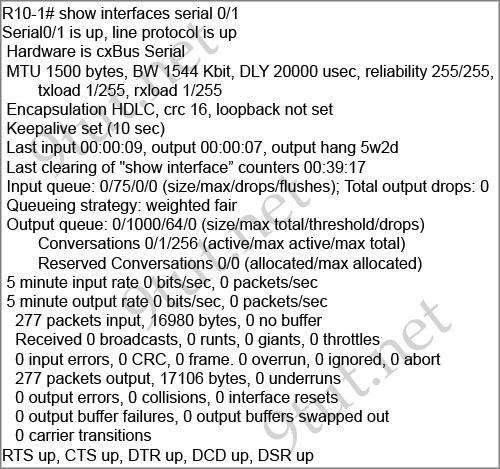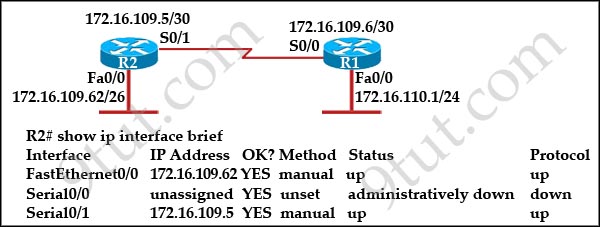ICND2 – WAN Questions
[am4show have=’p2;’]
Premium Member: You can test your knowledge with these questions first via this link.
[/am4show]
Question 1
[am4show have=’p2;’]Which two statements about using the CHAP authentication mechanism in a PPP link are true? (Choose two)
A. CHAP uses a two-way handshake.
B. CHAP uses a three-way handshake.
C. CHAP authentication periodically occurs after link establishment.
D. CHAP authentication passwords are sent in plaintext.
E. CHAP authentication is performed only upon link establishment.
F. CHAP has no protection from playback attacks.
Answer: B C[/am4show]
Explanation
Point-to-Point Protocol (PPP) can use either Password Authentication Protocol (PAP) or Challenge Handshake Authentication Protocol (CHAP) for authentication. CHAP is used upon initial link establishment and periodically to make sure that the router is still communicating with the same host. CHAP passwords arc exchanged as message digest algorithm 5 (MD5) hash values.
The three-way handshake steps are as follows:
Challenge: The authenticator generates a frame called a Challenge and sends it to the initiator. This frame contains a simple text message (sometimes called the challenge text). The message has no inherent special meaning so it doesn’t matter if anyone intercepts it. The important thing is that after receipt of the Challenge both devices have the same challenge message.
Response: The initiator uses its password (or some other shared “secret” that the authenticators also knows) to encrypt the challenge text. It then sends the encrypted challenge text as a Response back to the authenticator.
Success or Failure: The authenticator performs the same encryption on the challenge text that the initiator did. If the authenticator gets the same result that the initiator sent it in the Response, the authenticator knows that the initiator had the right password when it did its encryption, so the authenticator sends back a Success message. Otherwise, it sends a Failure message.
(Reference: CCNA Quick Reference Sheets)
Question 2
[am4show have=’p2;’]Refer to the exhibit. Hosts in network 192.168.2.0 are unable to reach hosts in network 192.168.3.0. Based on the output from RouterA, what are two possible reasons for the failure? (Choose two)

A. The cable that is connected to S0/0 on RouterA is faulty.
B. Interface S0/0 on RouterB is administratively down.
C. Interface S0/0 on RouterA is configured with an incorrect subnet mask.
D. The IP address that is configured on S0/0 of RouterB is not in the correct subnet.
E. Interface S0/0 on RouterA is not receiving a clock signal from the CSU/DSU.
F. The encapsulation that is configured on S0/0 of RouterB does not match the encapsulation that is configured on S0/0 of RouterA.
Answer: E F[/am4show]
Explanation
From the output we see the Serial0/0 of RouterA is in “status up/protocol down” state which indicates a Layer 2 problem so the problem can be:
+ Keepalives mismatch
+ Encapsulation mismatch
+ Clocking problem
Question 3
[am4show have=’p2;’]Which command is used to enable CHAP authentication with PAP as the fallback method on a serial interface?
A. (config-if)# authentication ppp chap fallback ppp
B. (config-if)# authentication ppp chap pap
C. (config-if)# ppp authentication chap pap
D. (config-if)# ppp authentication chap fallback ppp
Answer: C[/am4show]
Explanation
The command “ppp authentication chap pap” command indicates the CHAP authentication is used first. If it fails or is rejected by other side then uses PAP instead. If you want to use PAP first (then CHAP) you can use the “ppp authentication pap chap” command.
Question 4
[am4show have=’p2;’]Which Layer 2 protocol encapsulation type supports synchronous and asynchronous circuits and has built-in security mechanisms?
A. HDLC
B. PPP
C. X.25
D. Frame Relay
Answer: B[/am4show]
Explanation
PPP supports both synchronous (like analog phone lines) and asynchronous circuits (such as ISDN or digital links). With synchronous circuits we need to use clock rate.
Note: Serial links can be synchronous or asynchronous. Asynchronous connections used to be only available on low-speed (<2MB) serial interfaces, but now, there are the new HWICs (High-Speed WAN Interface Cards) which also support asynchronous mode. To learn more about them please visit http://www.cisco.com/en/US/prod/collateral/modules/ps5949/ps6182/prod_qas0900aecd80274424.html.
Question 5
[am4show have=’p2;’]At which layer of the OSI model does PPP perform?
A. Layer 2
B. Layer 3
C. Layer 4
D. Layer 5
Answer: A[/am4show]
Explanation
Layer 2 includes the popular WAN standards, such as the Point-to-Point Protocol (PPP), High-Level Data-Link Control (HDLC) and Frame Relay protocols.
Question 6
[am4show have=’p2;’]Which PPP subprotocol negotiates authentication options?
A. NCP
B. ISDN
C. SUP
D. LCP
E. DLCI
Answer: D[/am4show]
Explanation
Link Control Protocol (LCP) is a subprotocol within the Point-to-Point Protocol protocol suite that is responsible for link management. During establishment of a PPP communication session, LCP establishes the link, configures PPP options, and tests the quality of the line connection between the PPP client and PPP server. LCP automatically handles encapsulation format options and varies packet sizes over PPP communication links.
LCP also negotiates the type of authentication protocol used to establish the PPP session. Different authentication protocols are supported for satisfying the security needs of different environments.
Other subprotocol within PPP is Network Control Protocol (NCP), which is used to allow multiple Network layer protocols (routed protocols) to be used on a point-to-point connection.
Question 7
[am4show have=’p2;’]Which two options are valid WAN connectivity methods? (Choose two)
A. PPP
B. WAP
C. DSL
D. L2TPv3
E. Ethernet
Answer: A C[/am4show]
Question 8
[am4show have=’p2;’]Refer to the exhibit. Which WAN protocol is being used?

A. ATM
B. HDLC
C. Frame Relay
D. PPP
Answer: C[/am4show]
Explanation
Local Management Interface (LMI) is a signaling standard protocol used between your router (DTE) and the first Frame Relay switch. From the output we learn this interface is sending and receiving LMI messages -> Frame Relay is being used.
Question 9
[am4show have=’p2;’]Refer to the exhibit. The show interfaces serial 0/1 command was issued on the R10-1 router. Based on the output displayed which statement is correct?

A. The cable connected to the serial 0/1 interface of the R10-1 router is a DTE cable.
B. The R10-1 router can ping the router interface connected to the serial 0/1 interface.
C. The clock rate used for interface serial 0/1 of the R10-1 router is 1,544,000 bits per second.
D. The CSU used with the serial 0/1 interface of the R10-1 router has lost connection to the service provider.
E. The interface of the remote router connected to the serial 0/1 interface of the R10-1 router is using the default serial interface encapsulation.
Answer: E[/am4show]
Explanation
From the output, we see the the line “Serial0/1 is up, line protocol is up”. That means the link is good and the interface is functioning normally. Also the encapsulation used on this interface is HDLC -> The other end must use the same encapsulation. Otherwise the line protocol will go down.
Question 10
[am4show have=’p2;’]A network administrator needs to configure a serial link between the main office and a remote location. The router at the remote office is a non-Cisco router. How should the network administrator configure the serial interface of the main office router to make the connection?
A. Main(config)# interface serial 0/0
Main(config-if)# ip address 172.16.1.1 255.255.255.252
Main(config-if)# no shut
B. Main(config)# interface serial 0/0
Main(config-if)# ip address 172.16.1.1 255.255.255.252
Main(config-if)# encapsulation ppp
Main(config-if)# no shut
C. Main(config)# interface serial 0/0
Main(config-if)# ip address 172.16.1.1 255.255.255.252
Main(config-if)# encapsulation frame-relay
Main(config-if)# authentication chap
Main(config-if)# no shut
D. Main(config)# interface serial 0/0
Main(config-if)#ip address 172.16.1.1 255.255.255.252
Main(config-if)#encapsulation ietf
Main(config-if)# no shut
Answer: B[/am4show]
Explanation
“The router at the remote office is a non-Cisco router” so we cannot use HDLC which is a Cisco proprietary protocol -> A is not correct (HDLC is the default protocol on Cisco router for serial connection so we don’t need to type any command).
Frame Relay does not support authentication but if we run PPP over Frame Relay then we can use PAP or CHAP. Answer C does not have enough commands for this type of configuration -> C is not correct.
Cisco routers have two kinds of Frame Relay encapsulation: IETF or Cisco. A non-Cisco device does not understand “Frame Relay Cisco encapsulation” so if two routers use different kind of Frame Relay encapsulation, they cannot operate. So if we have a non-Cisco device we have to configure “encapsulation ietf” on both ends so that they can work. But the correct command should be “encapsulation frame-relay ietf” -> D is not correct.
Note: The “encapsulation frame-relay ietf” command uses to encapsulate outgoing frames with IETF. Incoming frames can still be decapsulated even if the interface is configured with “Cisco encapsulation”.
Question 11
[am4show have=’p2;’]Refer to the exhibit:

Assuming that the entire network topology is shown, what is the operational status of the interfaces of R2 as indicated by the command output shown?
A. One interface has a problem.
B. Two interfaces have problems.
C. The interfaces are functioning correctly.
D. The operational status of the interfaces cannot be determined from the output shown.
Answer: C[/am4show]


Thank you for getting the site back up. I need it for back up studying. i got a 735, missing the the 825 needed CCNA this Friday will send an update also the images are not showing up. it is giving the description of the .jpg but not the actual picture.
Took exam two days ago…questions #3, 5, 8, 9 were there but the order of the answers were different.
Don’t understand why responses to question 7 ?
Jordan,
B- WAP: Is mainly used in wireless and has nothing to do with WAN connectivity
D. L2TPv3: although can be used to tunnel across a WAN link it still requires something to connect the network to the WAN first.
E. Ethernet: probably wouldn’t use this to connect to a wan
A. PPP: is often used for WAN links due to its basic authentication
C. DSL: allows for other authentication methods such as PPPoA
Jordan
Ethernet is a Lan connectivity method,Wap is for wireless and L2TpV3 need a mediator,
so the rest two PPP and DSL are the answers.
PPP is used for asynchronous and synchronous and also for authentication
DSL live example can be seen for internet connectivity at home.
Ethernet technically can be used for WAN links so I’m not sure where to go with that one. An EFM line uses Ethernet technology and Leased lines are usually handed off via Ethernet.
I things the Key on Q7 is the word “Method” for that I think the correct answer is PPP and DSL, if you see Technhologies can be Ethernet and DSL and not PPP, you know we need think has cisco think
About Q11: Are you sure about the ip addresses and subnet masks on R2? “The interfaces are functioning correctly.” would be right if you look for Status and Protocol only. But the IP-adresses and subnet masks on the R2-interfaces would overlap each other. 172.116.109.62/26 covered the ip addresses 172.116.109.0 -> .63. So you cannot use 172.116.109.5 on the serial Interface.
+1 Donald, totally true..
So what would be the answer? A. or B. ?
Answer A. would be the best for Q11.
“C” appears correct to me simply because of how the question is framed. Cisco likes to trick people in this way.
It’s only asking about the status of the interfaces based on the output shown, not asking for you to consider the layer 3 ramifications. Regardless of IP addressing, the information about the interfaces based on the command used is functioning properly.
thanks for 9 tut the exam is really easy I pass witch 913
Took ICND2 earlier today, 986 / 1000.
Questions 2, 3, 9 from this page were on there.
Thanks 9tut. Great help.
2,3,5,9,10,11 were there
Passed today 1000. Got different configuration of the Eigrp & frame Relay labs where there were different DLCIs and IP addresses, but same process was used to get answers (show commands, show ip protocols, show ip interface brief ).
A question about GLBP and a question about netflow were on my test. You can find them here: http://www.examtut.com/2013/09/new-questions-in-ccna-200-120-hsrp-vrrp.html
Study 9tut and this guy i found him really helpful. He has unique way of teaching http://www.danscourses.com If you can do all his videos again and again. Trust me you will get the concept. Also one thing i learned today is if you don’t know the concept it’ll be hard for you in the exam.
All the best to every one in their path. Keep me in your good wishes.
took the exam today passed …all the questions were the same with those here and the nada file
For question 2, why is answer b not correct?
@john
Because the status is up that mean the cable is connected without any problem.
So protocol down mean u may not receive a clock rate or different layer 2 encapsulation tyres is on both end such as one running on PPP and the other running HDLC
Hi Friends,
yesterday , i had appeared for the ICND part 2 & secured 986 / 1000 . Thank you all , Thak
you 9 tut !!!!!!!!!
Took the exam today. Pass 986/1000. Q5, Q11 were on there.
Thanks 9tut.
passed ICND2 today and Question 2 and 4 was there. thanks 9tut.
how is it that so many people on this site are scoring 986 exactly?
I really hope I get a 986… I’m taking the exam today! Haven’t used 9tut much, mainly CBTNuggets. Wish me luck!
Related to Q11, the corect answer is C, because the problems about IP addressing are routing problems, no interface problems.
Question 2, 3, 8, 9 10, 11 all were on my exam. Passed with 937.
Tested today, 8/20. #2, 5, 9 were on there.
took the exam today and pass with 907. Question 2, 9 and 11 were on there, the others werent. location United States Florida.
test ICND 2
Thanks 9tut
Took ICND2 today 986/100. 2 4 5 8 9 & 11 were on there. Thanks 9TUT
On question 7. I would rather add option E. Ethernet.
The Ethernet WAN service does not define a concept like PVC (frame relay), However, Routers can send Ethernet frames to each other over the WAN using Ethernet WANs. Examples:
(EoMPLS) Ethernet over MPLS.
(MetroE) Metropolitan Ethernet.
(VPLS) Virtual Private LAN Service.
Basically, the customer routers uses Ethernet data link and there is no DLCI, but may show MAC Addresses in the WAN.
how can i open a+vce player
On question 2; I think should be 3 answer, adding answer B too!!.
If you shut down the interface administratively, the other side line protocol goes down. Try!!.
People who already scored 1000 and having this question on the test, do you remember the answer??. Thank you in advance!.
IPvcloud the answer is correct bcs there is no ip address assigned to the inter s0/0/0, therefore since is not in use the admin can shut, for example if R2 have assigned an Ip Add to connect to R1, but R1 inter s0/0/0 is down then there will a problem.
@Ipvcloud
I agree on #7 but do see why Cisco would stick with a standard answer (they can be tricky!) since Ethernet can be sent over Metropolitan Area Networks using ISP switches (UNI) that connect to customer premise Cisco routers/switches. I think the main keyword to watch for here is “WAN”.
Q2 and Q6 on my exam today
Q7 – Some people are saying E – Ethernet should be a correct option. But with the 100m limit on Ethernet, I’ve experienced problems in real life scenarios (in a huge call center) where a user at the far end of one of the buildings was having connectivity problems, and it turned out she was about 350′ away from the Comm Room. When I think of WAN, especially for test questions, I don’t consider it to be from one building to another building across the street. I think of it as one site being in NY and the other being in Kansas City.
2, 3,7, 9 and 10 on exam today ….passed 947
hi Associates,is there any time limit after one has passed the ICDN1 exam?how long does cisco allow for the person to take ICDN2?
Thanking You
Thank for the response Rahu.i don’t mean the period under which the certification is valid but on taking the two exams.Can one take ICND1 this week and take ICDN 2 the following week?Thanking You
Yes Morgan, you can do that. But why would you? You would still end with a CCNA, and since you don’t seem to need time to study in between, you should probably just go with the CCNA exam and not the 2-exam route. You’ll end up with a good mix of questions and LESS of them.
Q11 Has nobody noticed the overlapping subnets on R2 interfaces.
@John A few have spotted it, but are leaving it alone in favor of focusing on the “Based on the output shown” line. This could be argued very convincingly, but the point is that we need to pay attention to what they are asking in the question. Also, there is the possibility that the question was written incorrectly, but if you see it as is on the exam, focus on “The output” rather than over-thinking the real-world applications since these tests occasionally leave out those pesky factors.
Question 7
Which two options are valid WAN connectivity methods? (Choose two)
PPP and Ethernet
DSL is not a communication protocol by itself, a layer1 standard. It uses ATM or PPP at layer2
ref
http://en.wikipedia.org/wiki/List_of_network_protocols_(OSI_model)
@purna
Ethernet is a LAN connectivity. Look at the previous comments being answered to Q7.
passed on 3/13. questions 1,2,3, and 5. tks 9tut
2,3 and 9 were there today
Q2, 4 & 9 were there today
Q4 “With synchronous circuits we need to use clock rate.”
Not so. The clock is provided by the telco. A clock rate is only needed when one device is acting as a DCE, as may happen when connecting 2 routers together in a lab, via serial ports. However, there may be a bandwidth command, which sets the bandwidth used by routing protocols to determine the best path.
I got Q2, Q5, Q9 today in the ICND2 exam.
Thanks 9tut.
Q2,5,9. ICND2 today.
Question 11 is an example of why we need to read questions properly. The question based on the command output shown not the addressing scheme in the diagram…….. (Studying for ICND2)
Q2 & Q4 today.
Q10 needs to be corrected. Answer should be D not B. VCEs has the answer correct (using nada file).
guys download free dumps with nuggets from this following link
wurl. cc/dumps
Just took the test today – 980/1000 Questions 1,2, 3 and 4 were from this page. Thanks 9tuts! Also got Frame Relay, EIGRP and OSPF labs- a lot of OSPF & quite a few EIGRP questions!
Q11 Just to make sure no one else is misled… my guess is the LANs are separated by routers, so default/static routing could be in place for all we know. If Cisco gave us the “show ip route” output then probably a different story.
Side-note for some (NO OFFENSE)… let’s focus on WHY the answers are and not just WHAT they are. I have too many f’d up cell phone service and home internet issues from individuals being in a position they don’t have a logical understanding of. Nothing against this site at all… it’s an awesome study guide and prepares us for how literal the Cisco world (and the networking world in general) thinks… THANKS 9tut!!!
i present today all question are from 9tut thanks!!!
@all: We had to move all the questions and answers out of 9tut. We can only keep the explanation. You can download the questions and answers at: https://mega.co.nz/#!oIdESYbD!yyu33vygrfKPy4rcmcbV6qW2fxINNoTokuDM3CjA_og
What happened to the site? Are we going to get all the questions back up again?
Oh, nevermind. You already answered this.
Hello 9 Tut, please provide the link for the premium membership enrollment. thank you
On number 9, why cant B be a possible answer?
For Q9, isn’t option B also correct? since S0/1 is up, line protocol is up so the router R10-1 should be able to ping that interface
techgirl, I think B is incorrect because the router can’t ping its own S0/1 interface. It can only ping its loopback interface.
Regarding Q9 and ping across the serial link, no, the line protocol being up gives NO indication of whether or not you can ping across the link. PPP/HDLC is a layer 2 protocol. IP is layer 3. Hence, line protocol can be up w/o actually having network connectivity.
Q5,9,11 WAS TODAY AT MY ICND2 EXAM ..986/1000
Just tested today. Q5 has been updated to the following.
At which layer of the OSI model does RSTP perform?
A. Layer 2
B. Layer 3
C. Layer 4
D. Layer 5
Answer is B
Look on page 9 of the below link.
http://www.cisco.com/c/en/us/td/docs/optical/15000r7_0/ethernet/guide/454_327/r70ether/547swstp.pdf
@That Guy
RSTP does not work on Layer 3, RSTP is used on switches and switches are Layer 2 devices.
The most common initial deployment of RSTP is in the backbone and distribution layers of a Layer 2
switched network;
I apologize, that is a typo. Answer is A. Layer 2.
PLEASE!!! can anyone please send me the DUMPS for ICND-2 at my email s e y ex 007 at y a ho o dot c om
Q11+++++
R2 Default Ip address should be 172.16.109.1 /26
and other overlapping issue with serial connection.
”Two interface has problem.” must be the correct answer.
If you memorize all questions here on 9tut your score is not 1000.Most people here says 986/100.Thats why I guess.
JoeJack, it’s not asking about that. If that were an issue for this question, there would be no ipaddress period because the router would issue an error about overlapping interfaces. We need to only focus on the specific output of the picture not whether IP addressing is correct.
Q2. it cannot be B, because Administratively down is on S0/1 not S0/0. Be very careful when deciding.
NEW!! Super Crossbar Challenge Cheats NEW!!
Super Crossbar Challenge Hack tool for UNLIMITED COINS!
Get Super Crossbar Challenge Hack for Androidand iOS best!
DOWNLOAD LINK: Super Crossbar Challenge Cheat Tool
PLEASE!!! can anyone please send me the DUMPS at stevenandrews017 at gmail dot com